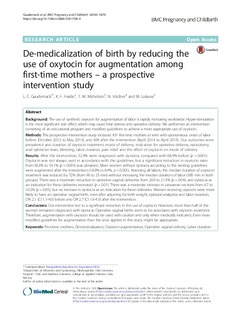| dc.description.abstract | Background: The use of synthetic oxytocin for augmentation of labor is rapidly increasing worldwide. Hyper-stimulation is the most significant side effect, which may cause fetal distress and operative delivery. We performed an intervention consisting of an educational program and modified guidelines to achieve a more appropriate use of oxytocin.
Methods: This prospective intervention study included 431 first-time mothers at term with spontaneous onset of labor before (October 2012 to May 2013), and 664 after the intervention (April 2014 to April 2015). Our outcomes were prevalence and duration of oxytocin treatment, mode of delivery, indication for operative delivery, episiotomy, anal sphincter tears, bleeding, labor duration, pain relief and the effect of oxytocin on mode of delivery.
Results: After the intervention, 52.9% were diagnosed with dystocia, compared with 68.9% before (p < 0.001). Oxytocin was not always used in accordance with the guidelines, but a significant reduction in oxytocin rates from 63.3% to 54.1% (p < 0.001) was obtained. More women without dystocia according to the existing guidelines were augmented after the intervention (18.9% vs 8.4%, p < 0.001). Assessing all labors, the median duration of oxytocin treatment was reduced by 72% (from 90 to 25 min) without increasing the median duration of labor (385 min in both groups). There was a moderate reduction in operative vaginal deliveries from 26.9 to 21.5% (p = 0.04), and dystocia as an indication for these deliveries increased (p = 0.01). There was a moderate increase in caesarean sections from 6.7 to 10.2% (p = 0.05), but no increase in dystocia as an indication for these deliveries. Women receiving oxytocin were more likely to have an operative vaginal birth, even after adjusting for birth weight, epidural analgesia and labor duration, OR: 2.1 (CI 1.1-4.0) before and OR 2.7 (CI 1.6-4.5) after the intervention.
Conclusions: Our intervention led to a significant reduction in the use of oxytocin. However, more than half of the women remained diagnosed with dystocia. Operative vaginal births seem to be associated with oxytocin treatment. Therefore, augmentation with oxytocin should be used with caution and only when medically indicated. Even more modified guidelines for augmentation than the ones applied in this study might be appropriate. | nb_NO |
